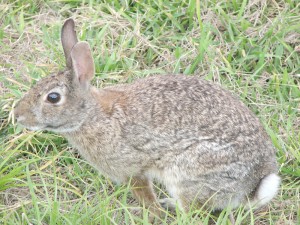Latest update February 10th, 2025 2:25 PM
Eastern cottontail (Sylvilagus floridanus)
May 31, 2015 Features / Columnists, Interesting Creatures in Guyana
The eastern cottontail (Sylvilagus floridanus) is a New World cottontail rabbit, a member of the family Leporidae. It is one of the most common rabbit species in North America.
The eastern cottontail can be found in meadows and shrubby areas in the eastern and south-central United States, southern Canada, eastern Mexico, Central America and South America.
In the mid-1960s, the Eastern cottontail was introduced to Cuba, Jamaica, Cayman Islands, Puerto Rico, Dominican Republic, Barbados, Bahamas, Haiti, Grenada, Guadeloupe, Saint Croix and northern Italy, where it displayed a rapid territorial expansion and increase in population density.
Optimal eastern cottontail habitat includes open grassy areas, clearings, and old fields supporting abundant green grasses and herbs, with shrubs in the area or edges for cover. The essential components of eastern cottontail habitat are an abundance of well-distributed escape cover (dense shrubs) interspersed with more open foraging areas such as grasslands and pastures.
Typically eastern cottontails occupy habitats in and around farms including fields, pastures, open woods, thickets associated with fencerows, wooded thickets, forest edges, and suburban areas with adequate food and cover. They are also found in swamps and marshes and usually avoid dense woods. They are seldom found in deep woods.
The eastern cottontail home range is roughly circular in uniform habitats. Eastern cottontails typically inhabit one home range throughout their lifetime, but home range shifts in response to vegetation changes and weather are common.
The eastern cottontail is chunky red-brown or grey-brown in appearance with large hind feet, long ears and a short fluffy white tail. Its underside fur is white. There is a rusty patch on the tail. Its appearance differs from that of a hare in that it has a brownish-grey colouring around the head and neck. The body is lighter colour with a white underside on the tail. It has large brown eyes and large ears, to see and listen for danger.
This rabbit is medium-sized, measuring 36–48 cm (14–19 in) in total length, including a small tail that averages 5.3 cm (2.1 in). Weight can range from 800 to 2,000 g (1.8 to 4.4 lb), with an average of around 1,200 g (2.6 lb). The female tends to be heavier, although the sexes broadly overlap in size. There may be some slightly variation in the body size of Eastern cottontails, with weights seeming to increase from south to north.
The eastern cottontail is a very territorial animal. When chased, it runs in a zigzag pattern, running up to 18 mph. The cottontail prefers an area where it can hide quickly but be out in the open.
Cottontails do not dig burrows, but rather rest in a form, a shallow, scratched-out depression in a clump of grass or under brush. It may use the dens of groundhogs as a temporary home or during heavy snow.
Eastern cottontails are crepuscular to nocturnal feeders; although they usually spend most of the daylight hours resting in shallow depressions under vegetative cover or other shelter; they can be seen at any time of day.
Eastern cottontails are most active when visibility is limited, such as rainy or foggy nights.
They usually move only short distances, and they may remain sitting very still for up to 15 minutes at a time. The diet of eastern cottontails is varied and largely dependent on availability. Eastern cottontails eat vegetation almost exclusively; arthropods have occasionally been found in pellets.
And this rabbit species has to contend with many predators, both natural and introduced. Due to their often large populations in Eastern North America, they form a major component of several predators’ diets.
Major predators of eastern cottontail include domestic dogs (Canis lupus familiaris), foxes (Vulpes and Urocyon spp.), coyote (C. latrans), bobcat (Lynx rufus), domestic cat (Felis catus), weasels (Mustela spp.), raccoon (Procyon lotor), mink (M. vison), great horned owl (Bubo virginianus), barred owl (Strix varia), hawks (principally Buteo spp.), corvids (Corvus spp.), and snakes.
Juvenile eastern cottontails are rare in the diet of short-eared owls (Asio flammeus). Trace amounts of eastern cottontail remains have been detected in black bear (Ursus americanus) scat.
(Source: Wikipedia – The Free Online Encyclopedia)
Share this:
- Click to print (Opens in new window)
- Click to email a link to a friend (Opens in new window)
- Click to share on Facebook (Opens in new window)
- Click to share on WhatsApp (Opens in new window)
- Click to share on Twitter (Opens in new window)
- Click to share on Pinterest (Opens in new window)
- Click to share on Pocket (Opens in new window)
- Click to share on Tumblr (Opens in new window)
- Click to share on Reddit (Opens in new window)
- Click to share on LinkedIn (Opens in new window)
Related
Similar Articles

The Glenn Lall Show|| February, 7th, 2025
Follow on Tik Tok @Glennlall
THE BLUNT OF THE DAY

Sports
Feb 10, 2025
Kaieteur Sports- The Guyana Boxing Association (GBA) has officially announced the national training squad, with the country’s top pugilists vying for selection to represent Guyana at the 2025...Features/Columnists
Forward to the past
Peeping Tom… Kaieteur News-Guyana’s debt profile, both foreign and domestic, has become a focal point of economic... more
OAS Secretary General Election and renewed OAS Consensus
Antiguan Barbudan Ambassador to the United States, Sir Ronald Sanders By Sir Ronald Sanders Kaieteur News- The upcoming election... more
Publisher’s Note
Freedom of speech is our core value at Kaieteur News. If the letter/e-mail you sent was not published, and you believe that its contents were not libellous, let us know, please contact us by phone or email.
Feel free to send us your comments and/or criticisms.
Contact: 624-6456; 225-8452; 225-8458; 225-8463; 225-8465; 225-8473 or 225-8491.
Or by Email: [email protected] / [email protected]
Weekend Cartoon
















